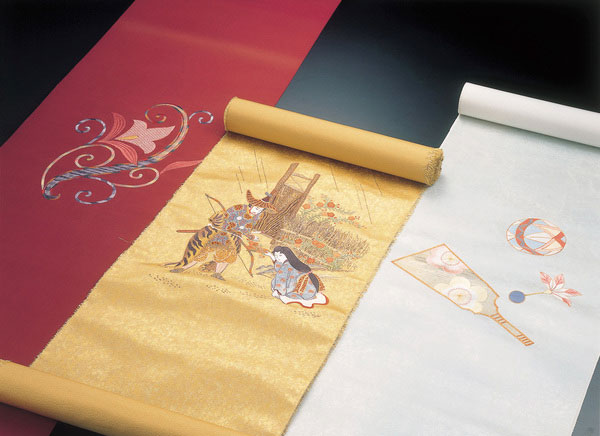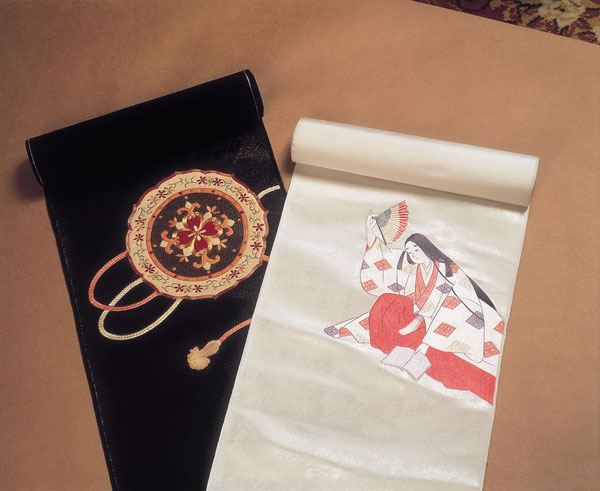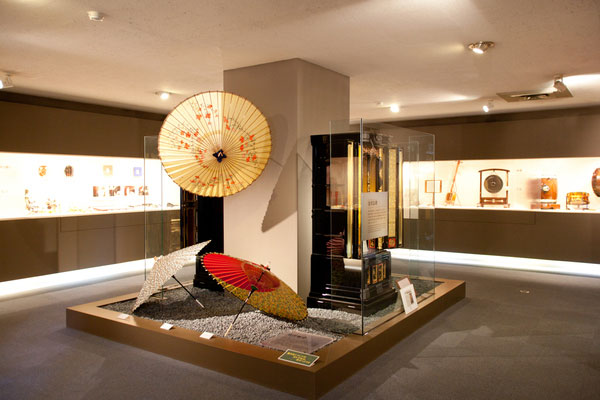 Photo:Ishikawa Prefecture Tourism League
Photo:Ishikawa Prefecture Tourism League
- Other textiles
- Ishikawa
Kaga embroidery Kaga nui
Pride of Kaga : aesthetic embroidery
Hand-dyed threads with sparkles of gold and silver
Description
What is Kaga embroidery ?
Kaga Embroidery (Kaga-nui in Japanese) is traditional embroidery produced in the city of Kanazawa, Ishikawa prefecture, using a variety of threads such as colorful silk threads, luxurious gold and silver threads, and lacquered threads. Kaga-nui is known for its relief designs delicately stitched with a gorgeous yet refined beauty. The key techniques include chain and slip stitches, and suga-nui, where threads are laid parallel to the weft of the fabric. Every single stitch is painstakingly worked by hand. Advanced techniques are also used such as relief stitch in which layers of embroidery are built up to make a three-dimensional design, and gradation stitch to give beautiful color grading by which different tones of silk threads are worked side by side. Unlike Kyo Embroidery where embroidery is applied directly to dyed patterns, for Kaga-nui, a design is drawn on plain fabric and embroidered, which creates a relief effect with distinctive presence. One of the advantages of Kaga-nui is by using twisted threads, an extremely durable embroidery finish is created. In addition, since the embroidery threads on the face and rear sides are stitched in the same direction, even if a thread is damaged, it can be repaired by fixing that particular section only. In recent years, the artistic beauty of Kaga-nui has been drawing increasing attention and in addition to luxury kimono, framed pictures, tapestries, room lamps, and other upholsteries incorporating the style are being produced.
History
 Photo: Ishikawa Prefecture Tourism League
Photo: Ishikawa Prefecture Tourism League
In Japan, embroidery started as shubutsu, embroidered images of the Buddha, and developed to create gorgeously colorful costumes for aristocrats and samurai in Kyoto. It is believed that embroidery was introduced from Kyoto to the Kaga region accompanying Buddhist missionaries in the early Muromachi period (1336 - 1573). During that time, embroidered Buddhist images on altar cloths or Buddhist priests' surplices were made and were much appreciated. In the Edo period (1603 - 1868), Kaga-nui found its way as an adornment for surcoats worn by Shoguns and feudal lords over their armor, their wives’ kimonos, and Kaga yuzen kimonos. It is believed that with the protection of the successive lords of the Kaga domain, Kaga-nui flourished along with gold leaf decoration and yuzen dyeing. Such traditional techniques never waned in and after the Meiji period (1868 - 1912). Women started to do western style embroidery as piecework at home, and from the Taisho period (1912 - 1926) through the Showa period (1926 - 1989), production of decorative collars and kimono sashes started. Subsequently, the number of factories and workers kept increasing, and the name of Kaga-nui became well known across the country. Their high-class kimono fabrics were made possible with the people of Kaga's pride and wealth as well as their high sense of beauty, and even today their exquisite and timeless craftsmanship is highly valued. Expansion in the future is also expected in the interior decor and decorative art field.
General Production Process
- 1. Drawing a design
Based on the artist’s original image, a design is drawn with a calligraphy brush and sumi ink or a pencil. Classic patterns include hanamaru mon (circle adorned with flowers), takara zukushi (treasures) and hidariuma (Chinese character for horse, but reversed). Tradition says that Matsu, wife of the famous general Toshiie MAEDA, was skilled at embroidery and developed a graceful pattern known as Kaga hanamaru mon, which spread throughout the domain. This pattern of small flowers is still embroidered on a broad range of items including kimonos, decorative collars, and small silk cloths called fukusa.
- 2. Copying onto the fabric
The ink design is placed on an under-lit glass stand and plain fabric is laid over it to accurately copy the design. When making a number of copies of the same pattern, a stencil made based on the design is placed on the cloth, and the design is copied onto the fabric with gofun (white pigment made from calcium carbonate).
- 3. Thread Dyeing
For Kaga-nui, threads are individually dyed for each item. Firstly, silk single thread is washed in plain cold water to remove dirt before soaking the thread in a water dye bath, and boiling. The colors are fixed with an acid and the threads are washed in water, wrung out, straightened and left to dry in the shade. As threads are dyed every time a new item is a produced, it is possible to create an infinite variety of subtle shades and tints.
- 4. Color scheme
The dyed threads and embroidery techniques are carefully selected to match the design and fabric. Threads selected from among countless colors are laid on the fabric, and as needed, silver and gold threads are added to create the final color scheme. This meticulous attention to color arrangement is also one of the key features of Kaga-nui.
- 5. Setting fabric on a frame
Large pieces are gently stretched and set on a large frame. A length of fabric is held at both ends by wooden rods and the cloth sides are held in place with looped darning-thread. It is important to ensure an overall moderate tension while taking care not to warp the fabric. Small pieces such as handkerchiefs and small family crests are set on a small square frame.
- 6. Thread Twisting
Using a hand-turned spinning wheel, lengths of thread are first spooled and then twisted to give the right shades and thickness. There are two types of twisting, hand twisting (teyori) and twisting with a tool (komayori). For hand twisting, threads are hooked to the stitching stand, and rolled up and down between the palms. For komayori threads, threads are hooked to a nail and after splitting and pulling in two directions, they are hooked onto both ends of a twisting stand, and tied to a tool called yorikoma, which is then rotated by hand.
- 7. Embroidery
Using many embroidery needles of different thicknesses, the design is meticulously stitched; Kaga-nui needles unlike the more usual foreign embroidery needles are handmade, of a uniform length and flat-headed.
By freely applying many traditional techniques such as relief stitch, satin stitch, and gradation stitch, delicate works in relief are produced.
- 8. Finishing
Dust attached during embroidery is thoroughly removed, and glue is applied onto the reverse side. After lightly wiping with a damp towel, the piece is dried to finish. As Kaga-nui has also developed in a form suitable for hand work in homes, there are many talented women artisans, bringing a delicate sensibility and skills to distinctively textured pieces finished with grace and a lightness of touch.
Where to Buy & More Information
Ishikawa Prefectural Museum of Traditional Arts and Crafts
 Photo:Ishikawa Prefecture Tourism League
Photo:Ishikawa Prefecture Tourism League
-
Address
-
Tel.+81-76-262-2020
-
ClosedApril to November: 3rd Thursday of the month / December to March: Thursdays / around the New Year
-
Business Hours9am to 5pm
-
Access1-1 Kenroku-machi, Kanazawa-shi, Ishikawa-ken
-
Website































































































































































































































































































